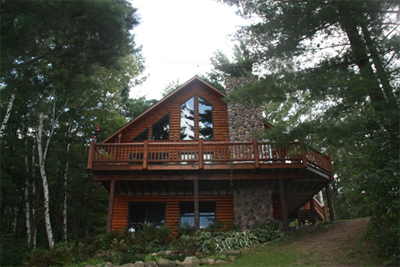Hyatt Regency Walkway Collapse




Haag Engineers were asked to determine the extent of structural damage caused by a felled tree that landed on a log home, and to distinguish possible damage from construction defects and/or long-term conditions.
Haag Engineers were asked to inspect a log home to determine the extent of structural damage caused by a felled tree that landed on the dwelling. During our inspection, we were also asked to distinguished tree impact damage from other construction defects and/or long-term conditions.
The main level wall structure comprised logs that were approximately 6-1/2 inches tall by 8 inches wide, and the top and bottom edges were milled with a double tongue-and-groove surface. Logs interlocked at corners with a saddle-style notch. Gable wall- and roof-framing were conventionally framed with sawn-lumber. The owner was concerned that the tree impact damaged the roof and misaligned the walls, which in turn misaligned the respective windows and doors. We utilized our knowledge of wood-frame construction; the characteristics of logs in log-style construction; and our experience with the effects of long-term conditions on structures versus recent impact forces on structures to determine the extent of damage caused by the tree impact and separate out the long-term conditions.
Whether its log home construction, conventionally framed structures, or structures with engineered wood products, Haag Engineers can determine the cause and extent of damages related to storms, long-term conditions, constructions defects, building code compliance, etc.

A six-level precast concrete parking garage collapsed during erection, resulting in multiple fatalities and injuries. Haag was tasked with determining the cause(s) of collapse and the cost of cleanup and rework.
Haag forensic engineers arrived on site of the collapse of a six-story precast concrete parking garage hours after the collapse. While the site was in the midst of rescue operations by county fire search and rescue Haag was involved in structural evaluation of the existing structure with county officials, OSHA, and numerous other parties. Haag performed a 3D laser scan to preserve the scene before debris was moved for recovery operations to establish member locations and conditions. We quickly provided a cost estimate for repairs/reconstruction including project schedule impacts.” We quickly provided an estimate for repairs including project schedule impacts.

Haag Engineers were asked to determine the cause of failure that led to overturning of a dragline and partial collapse into the mining pit.
Haag Consultants were asked to evaluate the sequence of events and conditions that led to overturning of a dragline used to remove stone blasted from the face of the mine pit. Analysis included consideration of site conditions, the effects of previous blasting, excavation procedures, and the involved equipment.

The metal chimney at a residence was struck by lightning during a severe thunderstorm. Major damage ensued.
A severe lightning strike hit a steel chimney cap and passed into a house in the North Texas area. Lightning entered the house through the metal chimney and was carried along corrugated steel gas tubing (CSST), copper electrical wiring, copper water piping, and the wooden structure itself.
The concussion broke gypsum drywall panels, burned electrical wiring insulation, damaged copper water piping, and melted multiple feet of CSST gas tubing. Minor fires occurred in the house but were extinguished before the house suffered major fire damage. Essentially all electrical and electronic devices in the house were damaged beyond repair. Two quarter-size holes were melted in the chimney cap. This was an early example of the dangers of lightning strike damage to a house utilizing CSST gas tubing. Haag engineers were called in to assess the complete scope of damage.

Haag Engineers were asked to determine the cause of a partial roof collapse at an industrial facility.
The roof of a steel-framed industrial facility had partially collapsed in one location, and excessive deflections were reported at several additional locations. The owner attributed these conditions to the weight of ice and snow on the roof. Haag Engineers inspected this roof and noted extensive deterioration of the cold-formed steel roof purlins at the collapse from long-term roof leaks. Our failure and damage inspection also revealed non-standard connections of purlins where excessive deflection was reported. While the weight of snow on the roof triggered the collapse, the root cause was loss of structural capacity of roof purlins from long-term deterioration of building components due to roof leaks.

Haag was asked to conduct a residential structural damage investigation and evaluation related to ground subsidence claim.
A homeowner was concerned after a 6-foot diameter, 3-1/2-foot-deep hole (dropout) opened up in the back yard at the property line. Sinkholes are common in the Tampa Bay area. At the time of the evaluation, Haag Engineers observed that a stormwater catch basin was located at the street in the vicinity of the property line. Further investigation revealed that a concrete stormwater pipe ran under the side property line and that it lay directly beneath the dropout. Soil had been washing into a hole in the pipe creating a void that eventually collapsed. The liability for correcting the problem shifted to the municipal stormwater utility.